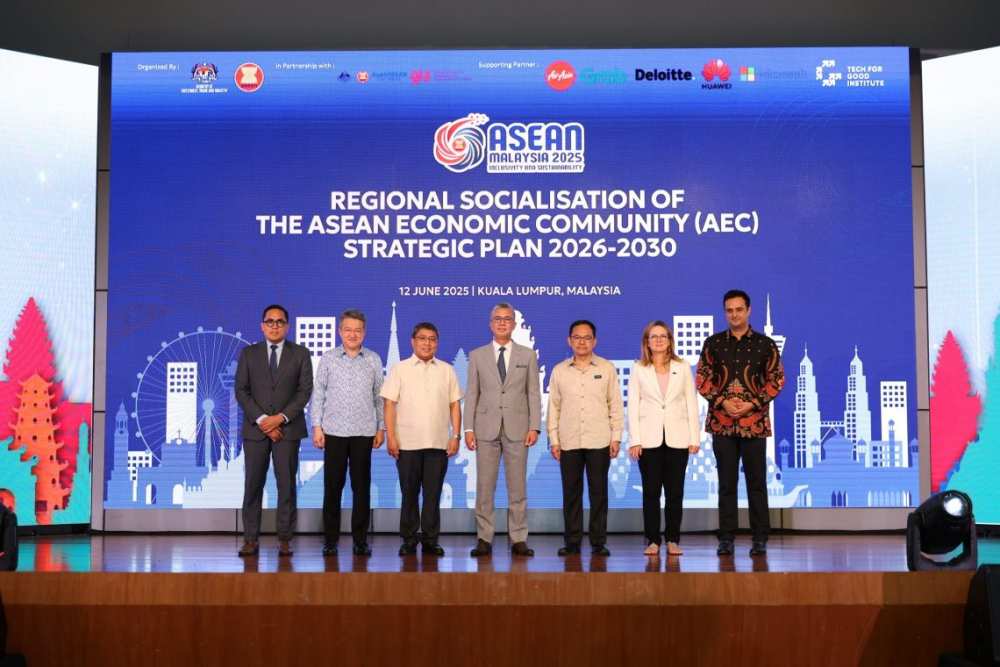Kuala Lumpur, June 12 (AseanAll) — ASEAN is poised to ascend as the world’s fourth largest economy, a milestone envisioned in the ASEAN Community Vision 2045: Our Shared Future, recently adopted by the ASEAN Leaders at the 46th ASEAN Summit. Integral to this compendium is the ASEAN Economic Community (AEC) Strategic Plan 2026 – 2030, which outlines key measures for building a prosperous, integrated, and innovation-driven economy, underpinned by an inclusive workforce and guided by sustainability principles.

To promote awareness of the key priorities under the AEC Strategic Plan 2026–2030, the Regional Socialisation on AEC Strategic Plan of the ASEAN Community Vision 2045, was convened on 12 June 2025 by the Chair of the ASEAN Economic Community Council (AECC) 2025 at the Ministry of Investment, Trade, and Industry of Malaysia, supported by the ASEAN Secretariat, Government of Australia, and Deutsche Gesellschaft für Internationale Zusammenarbeit (GIZ) GmbH. This Socialisation was also conducted in partnership with private sector representatives from various industries. The event gathered a total of over 500 participants attending onsite and online, from the business community, academia, civil society organisations (CSOs), students, ASEAN Member States, and other stakeholders.
“The AEC Strategic Plan marks another key milestone towards deepening economic integration and sustainable growth. It is structured in 5-year cycle until 2045 to maintain the relevance of ASEAN’s policies. Thus, we can be more responsive to the evolving trends and emerging challenges,” remarked Tengku Zafrul Abdul Aziz, the Chair of the ASEAN Economic Community Council (AECC) 2025 and the Minister of Investment, Trade, and Industry (MITI) of Malaysia during the Regional Socialisation.
The Socialisation featured two panel discussions which focused on exploring effective pathways to reimagine the ASEAN’s economic integration and resilience, while advancing an inclusive and sustainable future. The first panel discussion delved into discussions on reimagining single market and resilience, which includes ensuring businesses to gain benefit from the implementation of the AEC Strategic Plan 2026 – 2030. “We must address fragmentation and pursue greater harmonisation, which will provide businesses with operational flexibility—such as facilitated movement of personnel across regional offices, the ability to centralise backend operations in other ASEAN countries, adoption of non-restrictive shareholding structures, and access to tax incentives. We hope that the implementation of the AEC Strategic Plan 2026–2030 will help resolve the existing operational challenges and foster a more seamless and enabling environment for businesses,” said Jukhee Hong, the Executive Director of ASEAN Business Advisory Council (ASEAN-BAC) Malaysia on how businesses can effectively benefit from the Strategic Plan.
The second panel discussion centred on catalysing inclusive economic growth by positioning women, youth, and marginalised communities as co-creators in the implementation of the Strategic Plan. “Leaving no one behind should shift from bringing people along to including them from the outset of the strategic planning process and its implementation. This means co-creating impacts with rural communities, people of different age groups, and persons with disabilities (PwDs),” emphasised Jitsai Santaputra, Co-Founder of Youth for Energy Southeast Asia. From the vantage point of micro, small and medium enterprises (MSMEs) as key drivers of sustainable transition, Shameer Kanal, Cooperation Area Lead for ASEAN at the Deutsche Gesellschaft für Internationale Zusammenarbeit (GIZ) GmbH, added: “To ensure inclusivity in the benefits of integration for MSMEs, simplicity is essential. Integration is not just about multinationals and skyscrapers, but also about millions of small businesses across the region. Tailored financial solutions, capacity-building, and leveraging digitalisation are crucial to support MSMEs in advancing a green and inclusive transition during the course of the implementation of Strategic Plan.”
AEC Strategic Plan 2026 – 2030: Advancing Six Strategic Goals towards ASEAN’s Rise as A Key Economic Player
Forging future-ready pathways, the AEC Strategic Plan 2026–2030 sets a bold direction for deepening ASEAN’s economic integration. It is structured around six Strategic Goals, supported by 44 Objectives and 192 Strategic Measures. The Strategic Plan positions ASEAN to move forward as an action-oriented, sustainable, innovative, adaptable, and inclusive economic community.
The AEC Strategic Plan 2026–2030 sets out ASEAN’s aspiration to become a single market, while supporting a just, inclusive, and sustainable economic transition. Building on past achievements, the Plan strengthens cooperation across key areas such as digital transformation, innovation, MSMEs, intellectual property, consumer protection, energy, transport, minerals, tourism, among others. It also deepens ties with global and regional partners, boosts ASEAN’s standing in global value chains, and prepares for future trends. The Plan also prioritises resilient supply chains, strengthened energy and food security, sound economic policies, and effective responses to shifting job demands. Most importantly, it continues to narrow development gaps and opens more opportunities for businesses and communities to take part in and benefit from ASEAN’s economic integration.
Ultimately, ASEAN recognises that without robust institutional mechanisms, even most ambitious plans risk falling short in implementation. Therefore, ASEAN will implement a comprehensive monitoring framework and strengthen coordination across all three Community Pillars and Connectivity to ensure an integrated and coherent approach. The Strategic Plan will also mobilise strategic partnerships and resources from ASEAN’s External Partners and stakeholders to support its realisation.
With the official Socialisation of the AEC Strategic Plan 2026–2030, ASEAN has taken a decisive step toward shaping a resilient, sustainable, and inclusive future— one that aims to secure lasting prosperity for its people and communities and reaffirm the region’s role as a driving force in the global economy.